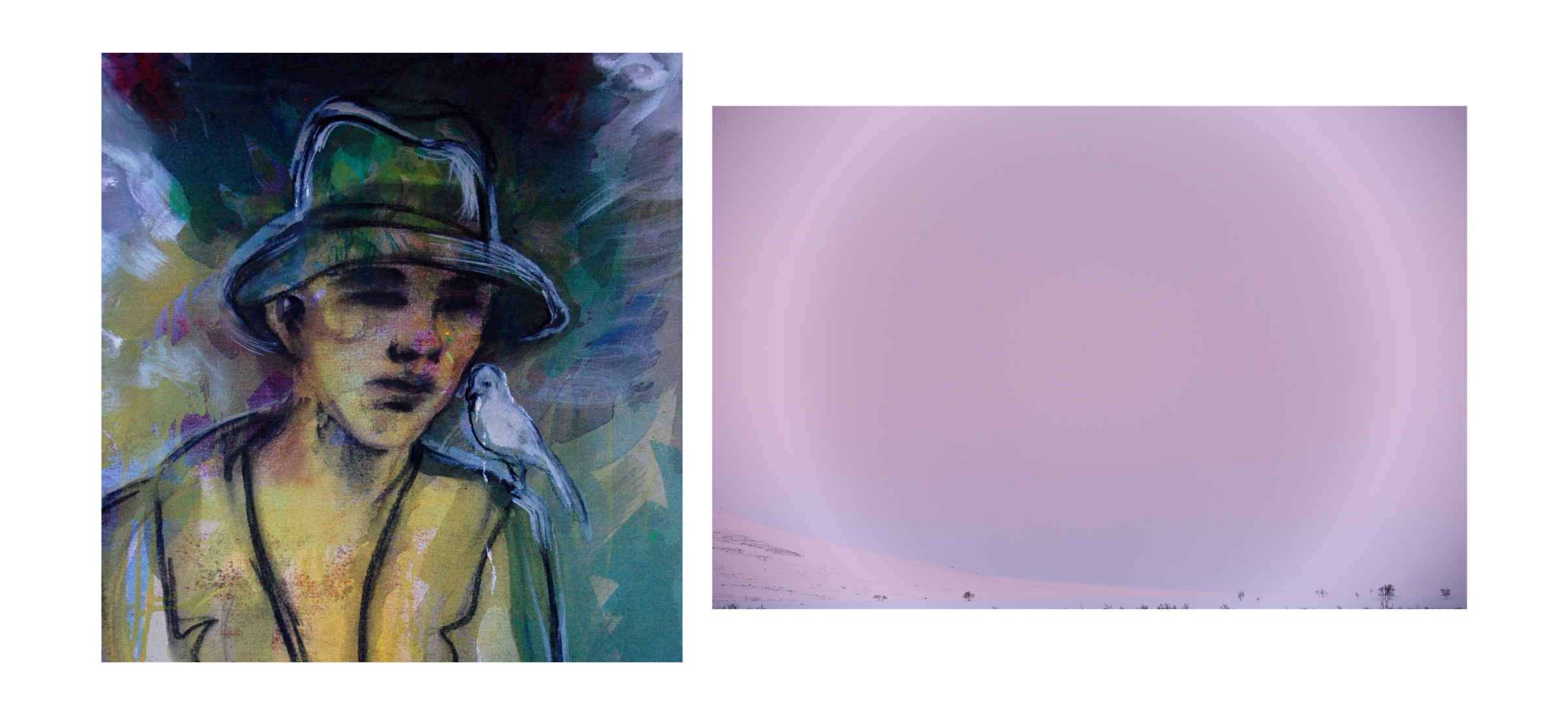Marikka Kiirikoff: Morning Star (Hall 1)
Marikka Kiirikoff’s paintings are full of emotion. There is a softness in the layering of the paint, yet the paintings are wild. Scratches, roughness of the surface and accurately represent details alternate and settle to the canvas without effort.
In “Leo” a suspicious young man looks at you. The young boy seems to be asking the viewer, do you even exist? Black hands rise from the bottle in his hand, perhaps they have destroyed the ability of the young man to be fully here, perhaps he lives in chanterelle-like thoughts that sparkle and flash brightly around him and slowly fade into the background. There is another separate face on the boy’s shoulders that looks like a newborn in his peaceful sleep. The boy seems to be bathing in the safe mossy green light radiating from the baby’s face. One of the boy’s hands is tightly holding on to the beer bottle. The boy’s other hand was perhaps a moment ago clenching fist. The third hand remains open, helplessly resting in front of the body. I recognize the face of the boy in the painting as the young man I met recently. Paintings are deeply personal portraits of their creator. I know that the boy is now dead.
In the cut-out paintings, Kiirikoff has cut three figures from the canvas and hung them up, like shadow puppets in a theater. They seem to metamorphose momentarily between the forms of human, plant and animal. One fairy-like creature has bare hip, thigh and leg bones and is supported by a group of white doves. An ominous composite figure of a bird, skull and plant hangs beside the creature. Among them is a human-faced mythical creature with a face that feels like it’s underwater and has black algae-like growth on its feet. The scene of the three characters is impressive and dark.
Wrapped in long wooden sticks collected from the forest, the gigantic assembly of several different paintings is like a large patchwork of paintings. The whole thing looks impressive. Does the installation made of paintings form a hut? It feels like it’s something sacred that you could even step inside and rest in. In the enormously large ensemble, there are paintings of space, diaper change and the yard of an apartment building in a bright light. There is also a yard of the wooden house which glows in a wonderful yellow color with people in different situations, different eras and different realities. The flames of a campfire in one painting seem to rattle the security, while the plant rising from the sink seems ominous, even the soap is red as a warning sign.
Is assembling the paintings into a cozy hut an indication of the desire to get away from the surfaces of the paintings? Collected and sewn into a large canvas in this way, several different paintings appear not only as a surface to show the wonders and grievances of life, but also as oppressed matter. On the other hand, only as a colourful canvas fixed in form, the paintings are a sanctuary, like a place to live bringing security and comfort.
There is magic in Kiirikoff’s paintings. The colours are glowing and alive. Bodily sensations are described accurately and quickly, and the gloomy encounters can, glowingly, lead you to dream of something better.
Text (freely translated): Anna Katariina Poranen, M.A.
Sara Ilveskorpi: The Acoustics of Snow (Hall 2)
The Acoustics of Snow exhibition follows the paths of place-bound practice from Kemiönsaari to Kilpisjärvi, where Sara Ilveskorpi has worked on home stead and at the Ars Bioarctica residency of the Finnish Bioart Society. The exhibition consists of photography and glass castings as well as melting and freezing. Art works and documentary fragments are displayed side by side. In the project, the word acoustics rather aims at the resonance of snow (or the lack of it) rather than the actual soundscape. As inner sound of the subarctic and arctic region it resonates in the beings of living and non-living. Ilveskorpi explores the feel of snow moving in the middle ground of ecology, material physiology, cultural history, and aesthetics.
In the exhibition, the action is connected to the place and is intertwined with the bodily experience. Documentary is part of the structure of the exhibition. However, Sara Ilveskorpi does not want to exoticize unique moments. Instead, she focuses to understand and consider biological and cultural starting points. Ilveskorpi wanted to display her exhibition in the HAA Gallery because of its location and snow cave-like architecture. She hopes that making the journey will bring the experiencer closer to the encountered.
Sara Ilveskorpi (born 1970) is a multidisciplinary visual artist, art educator, doctoral researcher, and gardener from plant production. She earned her bachelor from the Turku Academy of Arts and master’s from the Aalto University’s Department of Art. She is currently working on her doctoral studies at Aalto University at the Department of Art and Media. The central concept of her research is self-sufficiency. Ilveskorpi’s last solo exhibition was at the Heinola Art Museum in the summer of 2023. She has participated in numerous joint exhibitions, e.g., XXV Art Weeks in Mänttä. Sara Ilveskorpi’s artistic practice is place-bound. She strives for interactive gesture with the ecology of the place.
Sara Ilveskorpi’s work has been supported by The Arts Promotion Centre Finland, Aalto University and Bioart Society.


